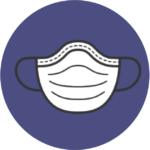
Symptom Screening – Low Risk and High Risk – Protocol for Keeping Students Home and Restrictions to Meet Before Returning to School
The Montana Department of Public Health and Human Services and the Governor’s Office recently released a new publication entitled, “Outbreak Response Protocols: K-12” https://dphhs.mt.gov/aboutus/news/2020/responseprotocolsforschools. Based on this new guidance document, and in collaboration with Lewis and Clark Public Health, we have made a change to our District protocol.
High Risk Symptoms:
- Coughing with or without chest congestion
- Shortness of breath or difficulty breathing
- Loss of Taste or Smell
Low Risk Symptoms:
- Vomiting/Nausea/Stomachache
- Diarrhea
- Sore Throat
- Muscle Aches or Pain
- Headache
- Weakness or Fatigue
- Runny Nose or Nasal Congestion
- Fever (> 100.4 F) or Chills
If the student has 1 new or unexplained Low-Risk Symptom and has had NO exposure to someone with COVID-19, student must stay home until 24 hours after symptoms are improving without the use of fever/pain reducing medication.
If the student has 1 new or unexplained High-Risk symptom or 2 new or unexplained Low-Risk symptoms and has had NO exposure to someone with COVID-19, student must remain home until one of the following criteria are met:
- Parent provides a note from their health care provider clearing the student for school. Under this circumstance, student may return 24 hours after the fever is gone and symptoms are improving without the use of fever/pain reducing medications.
- 2.If a health care provider’s note clearing the student for school is NOT provided, the student may return if they provide a negative PCR COVID-19 test and 24 hours after the fever is gone and symptoms are improving without the use of fever/pain reducing medications.
- If the student does not get a PCR COVID-19 test or consult their health care provider, they must remain home for 10 days and symptoms have improved.
*If you have questions, please contact your school nurse.
- Check the list of COVID-19 Symptoms
(from the Montana Outbreak Response Protocols K-12 document) - Learn why there won’t be temperature screening in schools
- View the Nurses’ Symptom Form

Wash your hands with soap and water for at least 20 seconds
Wash your hands with soap and water for at least 20 seconds. According to the American Academy of Family Physicians, proper hand-washing remains the number one tool for reducing the spread of germs that cause illnesses like COVID-19. Another easy hygiene rule is covering your sneezes and coughs with a tissue, and then throwing the tissue into the trash.
Additional Hand-washing References
Stay Current on your Vaccinations
Vaccinations introduce weakened or inactive parts of germs to your immune system so your body can fight it if it’s later exposed to the germ. Getting vaccinated is not just something you do for yourself. Keeping up with your vaccines also protects your family, friends, and teachers from harmful diseases. The Center for Disease Control has more information on the importance of vaccines.
Resources for Vaccinations

Wear a Mask the Correct Way
Health experts say the evidence is clear that masks can help prevent the spread of COVID-19 and that the more people wearing masks, the better. Tiny droplets are created whenever someone sneezes, coughs, or talks. Those droplets can contain germs like COVID-19. Wearing a mask over your nose and mouth helps filter out the germs.
 Maintain Social Distancing
Maintain Social Distancing
Viruses are often spread to another person by small droplets from a sick person’s cough or sneeze. Most of these droplets would fall to the ground before reaching the uninfected person if they are 6 feet apart.
Also, when a person has been found to have COVID-19, Lewis and Clark Public Health nurses talk with them about who they have spent time with for 48 hours before they developed symptoms. If you have been within 6 feet of the sick person for 15 minutes or several times for less than 15 minutes then you will be a “close contact”. The Lewis and Clark Public Health Officer will send an order for you to quarantine (stay at home) for 10 days. If you have been able to stay six feet apart then you will not be considered a close contact and you will not have to quarantine.
